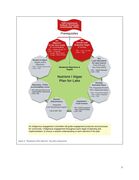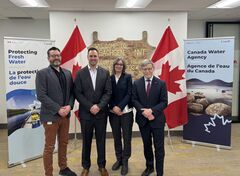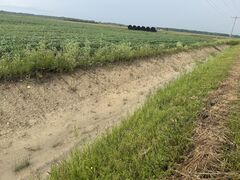Persistent algal blooms in Lake of the Woods and elsewhere in its watershed underscore the importance of developing a Phosphorus Management Plan (PMP) for the Rainy-Lake of the Woods basin.
Phosphorus (P) is the nutrient that controls the growth of algae in lakes within the basin.
Framework for a Domestic Phosphorus Management Plan
 Following public consultations led by Environment and Climate Change Canada (ECCC) in 2021 to seek public input on the development of Lake Ecosystem Objectives and potential phosphorus reduction targets for Lake of the Woods, in 2022, LOWWSF drafted a framework for a domestic PMP development process for Canada.
Following public consultations led by Environment and Climate Change Canada (ECCC) in 2021 to seek public input on the development of Lake Ecosystem Objectives and potential phosphorus reduction targets for Lake of the Woods, in 2022, LOWWSF drafted a framework for a domestic PMP development process for Canada.
With funding support from the Government of Canada through ECCC, the Framework for a Domestic
Phosphorus Management Plan for the Rainy River and Lake of the Woods provides step-by-step guidance and rationale for the process to develop a PMP for Canadian waters in the Rainy-Lake of the Woods Watershed.
This framework outlines the process that is required to develop a domestic PMP for the Canadian portion of the Rainy-LoW basin. Detailed PMPs such as Minnesota’s TMDL study have been developed for areas of the basin outside of Canada and these have included loads from outside the US. Although a domestic PMP will address Canadian sources of P within the basin the overall objective is to consider and combine binational P reduction strategies to achieve desired nutrient reduction goals for waters within the basin which are a shared resource. The framework provides details with respect to all jurisdictions and areas of authority (including Indigenous Nations) that would be required to provide input to the plan.
Developing a Domestic Phosphorus Management Plan for Lake of the Woods
 Since the Foundation’s inception – and indeed, long before that - algae blooms have been a consistent water quality concern facing Lake of the Woods. In our watershed, phosphorus is the primary nutrient driving these blooms. In recent decades, blooms have become more frequent, toxic and now last later in the year, often well into the fall.
Since the Foundation’s inception – and indeed, long before that - algae blooms have been a consistent water quality concern facing Lake of the Woods. In our watershed, phosphorus is the primary nutrient driving these blooms. In recent decades, blooms have become more frequent, toxic and now last later in the year, often well into the fall.
In late 2024, the Lake of the Woods Water Sustainability Foundation began moving forward a key action to address the algae problem from the Canadian side of the watershed. From 2024 until March 2027, with the support of the Canada Water Agency’s Freshwater Ecosystem Initiative for Lake of the Woods, our team will be focused on developing Canada’s domestic phosphorus management plan for Rainy-Lake of the Woods.
 We will be working with local communities, knowledge keepers, stakeholders and experts in the Canadian portions of Rainy River and the Lake of the Woods to develop a domestic phosphorus management plan that will, like the plan already underway in Minnesota, support international water quality goals.
We will be working with local communities, knowledge keepers, stakeholders and experts in the Canadian portions of Rainy River and the Lake of the Woods to develop a domestic phosphorus management plan that will, like the plan already underway in Minnesota, support international water quality goals.
We are fortunate to be able to access the expertise and technical capacity of Indigenous nations in our watershed. Additionally, our work will build on the legacy of other outstanding scientific and technical inquiry and policymaking in the Rainy-Lake of the Woods watershed, including the Government of Canada’s international science and modelling studies of the lake that began in 2016, Minnesota’s Total Maximum Daily Load study on excess nutrients for Lake of the Woods which ran from 2004-2015 and the state’s associated restoration plan (published in 2021), and an international network of Indigenous, provincial, state, county, and federal water quality monitoring efforts.
For this project, our task involves establishing a network of interested parties to support this planning work. Together we will develop a framework to monitor and review progress toward achieving desired phosphorus-reduction outcomes for Lake of the Woods. We anticipate this framework will support the IJC Board’s alert levels for nutrients and algae, as well as any related future international water quality objectives.
 In January 2025, we launched the project steering committee – a group of about 10 sectoral leaders, academics, and community experts and knowledge keepers who will provide high level oversight and guidance as the project progresses. We are working with two project working groups, as well as an Indigenous engagement committee. Interaction and communication between the steering committee and the Indigenous Engagement Committee are crucical to ensuring our work is well-informed by both traditional Indigenous resource management, ecological, and sociological knowledge, as well as practical experiences from non-Indigenous land managers and practitioners across many sectors.
In January 2025, we launched the project steering committee – a group of about 10 sectoral leaders, academics, and community experts and knowledge keepers who will provide high level oversight and guidance as the project progresses. We are working with two project working groups, as well as an Indigenous engagement committee. Interaction and communication between the steering committee and the Indigenous Engagement Committee are crucical to ensuring our work is well-informed by both traditional Indigenous resource management, ecological, and sociological knowledge, as well as practical experiences from non-Indigenous land managers and practitioners across many sectors.
Of the two project working groups, one is examining point sources – permitted wastewater facilities – and their task will be to assess whether and where it might be possible to reduce loads even further under those permits, or what resources are needed to ensure continued compliance under permits. The other group is look at non-point sources – the nutrients that flow from the landscape and may be related to agriculture, forestry, mining, development, and other land-use changes, as well as natural sources including erosion, sediment transfer and airborne sources. That group will help to identify areas that can be targeted for phosphorus abatement, as well as strategies to do so.
Our work will continue through March 2027 to build a robust network of people and groups eager to tackle the algae problem together by helping to build, and eventually execute, the domestic phosphorus management plan for Rainy-Lake of the Woods.
